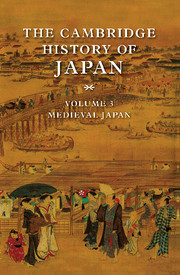Book contents
- Frontmatter
- Introduction
- 1 The Kamakura bakufu
- 2 Medieval shōen
- 3 The decline of the Kamakura bakufu
- 4 The Muromachi bakufu
- 5 Muromachi local government: shugo and kokujin
- 6 The decline of the shōen system
- 7 The medieval peasant
- 8 The growth of commerce in medieval Japan
- 9 Japan and East Asia
- 10 CULTURAL LIFE IN MEDIEVAL JAPAN
- 11 The other side of culture in medieval Japan
- 12 Buddhism in the Kamakura period
- 13 Zen and the gozan
- Works cited
- Glossary
- Index
- References
1 - The Kamakura bakufu
Published online by Cambridge University Press: 28 March 2008
- Frontmatter
- Introduction
- 1 The Kamakura bakufu
- 2 Medieval shōen
- 3 The decline of the Kamakura bakufu
- 4 The Muromachi bakufu
- 5 Muromachi local government: shugo and kokujin
- 6 The decline of the shōen system
- 7 The medieval peasant
- 8 The growth of commerce in medieval Japan
- 9 Japan and East Asia
- 10 CULTURAL LIFE IN MEDIEVAL JAPAN
- 11 The other side of culture in medieval Japan
- 12 Buddhism in the Kamakura period
- 13 Zen and the gozan
- Works cited
- Glossary
- Index
- References
Summary
The establishment of Japan's first warrior government, the Kamakura bakufu, represented both a culmination and a beginning. Since the tenth century, an increasingly professionalized class of mounted fighting men had served in local areas as estate administrators and policemen and as officials attached to the organs of provincial governance. By the twelfth century, warriors had come to exercise a dominant share of the total volume of local government, but even after two hundred years they remained politically immature. The most exalted warriors were still only middle-level figures in hierarchies dominated by courtiers and religious institutions in and near the capital. The bakufu's founding in the 1180s thus represented an initial breakthrough to power on the part of elite fighting men, but the fledgling regime was scarcely in a position to assume unitary control over the entire country. What evolved was a system of government approximating a dyarchy. During the Kamakura period, Japan had two capitals and two interconnected loci of authority. The potential of warrior power was clear enough to those who cared to envision it, but the legacy of the past prevented more than a slow progress into the future.
Until quite recently, studies of Kamakura Japan have tended to overstate the warriors' achievement, by equating the creation of a new form of government with the simultaneous destruction of the old. As is now clear, not only was the Heian system of imperial-aristocratic rule still vigorous during the twelfth century, but also it remained the essential framework within which the bakufu, during its lifetime, was obliged to operate.
- Type
- Chapter
- Information
- The Cambridge History of Japan , pp. 46 - 88Publisher: Cambridge University PressPrint publication year: 1990
References
- 8
- Cited by

